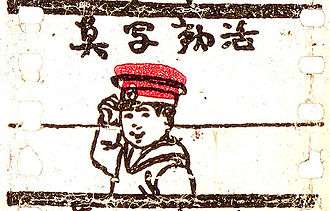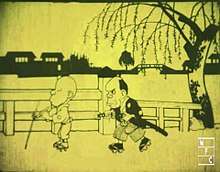Katsudō Shashin
Katsudō Shashin (活動写真, "motion picture"), sometimes called the Matsumoto fragment, is a 1907 Japanese animated filmstrip that is the oldest known work of animation from Japan. Its creator is unknown. Evidence suggests it was made before 1912, so it may predate the earliest displays of Western animated films in Japan. It was discovered in a collection of films and projectors in Kyoto in 2005.

The three-second filmstrip depicts a boy who writes "活動写真", removes his hat, and bows. The frames were stencilled in red and black using a device for making magic lantern slides, and the filmstrip was fastened in a loop for continuous play.
Description
Katsudō Shashin consists of a series of cartoon images on fifty frames of a celluloid strip and lasts three seconds at sixteen frames per second.[1] It depicts a young boy in a sailor suit who writes the kanji characters "活動写真" (katsudō shashin, "moving picture") from right to left, then turns to the viewer, removes his hat, and bows.[1] Katsudō Shashin is a provisional title for the film, whose actual title is unknown.[2]
Unlike in traditional animation, the frames were not produced by photographing the images, but rather were impressed onto film using a stencil.[3] This was done with a kappa-ban,[lower-alpha 1] a device for stencilling magic lantern slides. The images were in red and black on a strip of 35 mm film[lower-alpha 2][4] whose ends were fastened in a loop for continuous viewing.[5]
Background
Early printed animation films for optical toys such as the zoetrope predated projected film animation. German toy manufacturer Gebrüder Bing presented a cinematograph at a toy festival in Nuremberg in 1898; soon other toy manufacturers sold similar devices.[6] Live-action films for these devices were expensive to make; possibly as early as 1898 animated films for these devices were on sale, and could be fastened in loops for continuous viewing.[7] Imports of these German devices appeared in Japan at least as early as 1904;[8] films for them likely included animation loops.[9]

Projected film technology arrived in Japan from the West in 1896–97.[10] The earliest display of foreign animation in Japanese theatres that can be dated with certainty is of the French animator Émile Cohl's The Nipper's Transformations[lower-alpha 3] (1911), which premièred in Tokyo on 15 April 1912. Works by Ōten Shimokawa, Seitarō Kitayama, and Jun'ichi Kōuchi in 1917 were the first Japanese animated films to reach theatre screens.[11] The films are lost, but a few have been discovered in "toy movie"[lower-alpha 4] versions for viewing at home on hand-cranked projectors; the oldest to survive is Hanawa Hekonai meitō no maki[lower-alpha 5] (1917), titled Namakura-gatana in its home version.[12]
Rediscovery
In December 2004, a secondhand dealer in Kyoto contacted Natsuki Matsumoto,[lower-alpha 6][3] an expert in iconography at the Osaka University of Arts.[13] The dealer had obtained a collection of films and projectors from an old Kyoto family, and Matsumoto arrived the next month to fetch them.[3] The collection included three projectors, eleven 35 mm films, and thirteen glass magic lantern slides.[3]
When Matsumoto found Katsudō Shashin in the collection,[13] the filmstrip was in poor condition.[14] The collection included three Western animated filmstrips;[15] Katsudō Shashin may have been made in imitation of such examples of German or other Western animation.[15] Based on evidence such as the likely manufacture dates of the projectors in the collection, Matsumoto and animation historian Nobuyuki Tsugata[lower-alpha 7] determined the film was most likely made in the late Meiji period, which ended in 1912;[lower-alpha 8][16] historian Frederick S. Litten has suggested c. 1907 as a likely date,[2] and that "a production date before 1905 or after 1912 is unlikely".[9] At the time, movie theatres were rare in Japan;[5] evidence suggests Katsudō Shashin was mass-produced to be sold to wealthy owners of home projectors.[17] The creator of the filmstrip remains unknown;[13] to Matsumoto, the relatively poor quality and low-tech printing technique indicate it was likely from a smaller company.[9]
The discovery was widely covered in Japanese media.[3] Given its speculated date of creation, the film would have been contemporary to—or even have predated—early animated works by Cohl and the American animators J. Stuart Blackton and Winsor McCay. The newspaper Asahi Shimbun acknowledged the importance of the discovery of Meiji-period animation, but expressed reservations about placing the film in the genealogy of Japanese animation, writing that it is "controversial that [Katsudō Shashin] should even be called animation in the contemporary sense".[14]
See also
Notes
- 合羽版 kappa-ban; the printing process was called kappa-zuri (合羽刷り)
- The filmstrip has since shrunk to 33.5 mm.[2]
- French: Les Exploits de Feu Follet; Japanese: ニッパルの変形 Nipparu no Henkei
- 玩具 gangu
- 塙凹内名刀之巻 Hanawa Hekonai meitō no maki, "Filmreel of Hanawa Hekonai's famous sword"
- 松本 夏樹 Matsumoto Natsuki, b. 1952
- 津堅 信之 Tsugata Nobuyuki, b. 1968
- The Meiji period lasted from 1868 to 1912.
References
- Anime News Network staff 2005.
- Litten 2014, p. 13.
- Matsumoto 2011, p. 98.
- Matsumoto 2011, p. 116.
- Asahi Shimbun staff 2005.
- Litten 2014, p. 9.
- Litten 2014, p. 10.
- Litten 2014, p. 14.
- Litten 2014, p. 15.
- Matsumoto 2011, p. 112.
- Litten 2013, p. 27.
- Matsumoto 2011, pp. 96–97.
- Clements & McCarthy 2006, p. 169.
- López 2012, p. 584.
- Litten 2014, p. 12.
- Matsumoto & Tsugata 2006, p. 101; Matsumoto 2011, p. 115.
- Matsumoto 2011, pp. 116–117.
Works cited
- Anime News Network staff (7 August 2005). "Oldest Anime Found". Anime News Network. Archived from the original on 2 February 2007. Retrieved 12 February 2014.CS1 maint: ref=harv (link)
- Asahi Shimbun staff (1 August 2005). "Nihon saiko? Meiji jidai no anime firumu, Kyōto de hakken" 日本最古?明治時代のアニメフィルム、京都で発見 [Oldest in Japan? Meiji-period animated film discovered in Kyoto]. China People's Daily Online (Japanese Edition) (in Japanese). Archived from the original on 11 October 2007. Retrieved 11 June 2014.CS1 maint: ref=harv (link)
- Clements, Jonathan; McCarthy, Helen (2006). The Anime Encyclopedia: A Guide to Japanese Animation Since 1917. Stone Bridge Press. ISBN 978-1-84576-500-2.CS1 maint: ref=harv (link)
- Litten, Frederick S. (2013). "Shōtai kenkyū nōto: Nihon no eigakan de jōei sareta saisho no (kaigai) animēshon eiga ni tsuite" 招待研究ノート:日本の映画館で上映された最初の(海外)アニメーション映画について [On the Earliest (Foreign) Animation Shown in Japanese Cinemas]. The Japanese Journal of Animation Studies (in Japanese). 15 (1A): 27–32.CS1 maint: ref=harv (link)
- Litten, Frederick S. (17 June 2014). "Japanese color animation from ca. 1907 to 1945" (PDF). litten.de. Archived from the original (PDF) on 14 July 2014. Retrieved 18 June 2014.CS1 maint: ref=harv (link)
- López, Antonio (2012). "A New Perspective on the First Japanese Animation". Published proceedings‚ Confia‚ (International Conference on Illustration and Animation)‚ 29–30 Nov 2012. IPCA. pp. 579–586. ISBN 978-989-97567-6-2.CS1 maint: ref=harv (link)
- Matsumoto, Natsuki; Tsugata, Nobuyuki (2006). "Kokusan saikō to kangaerareru animēshon firumu no hakken ni tsuite" 国産最古と考えられるアニメーションフィルムの発見について [The discovery of supposedly oldest Japanese animation films]. Eizōgaku (in Japanese) (76): 86–105. ISSN 0286-0279.CS1 maint: ref=harv (link)
- Matsumoto, Natsuki (2011). "映画渡来前後の家庭用映像機器" [Home movie equipment from the earliest days of film in Japan]. In Iwamoto, Kenji (ed.). Nihon eiga no tanjō 日本映画の誕生 [Birth of Japanese film] (in Japanese). Shinwa-sha. pp. 95–128. ISBN 978-4-86405-029-6.CS1 maint: ref=harv (link)
External links

- Katsudō Shashin on IMDb